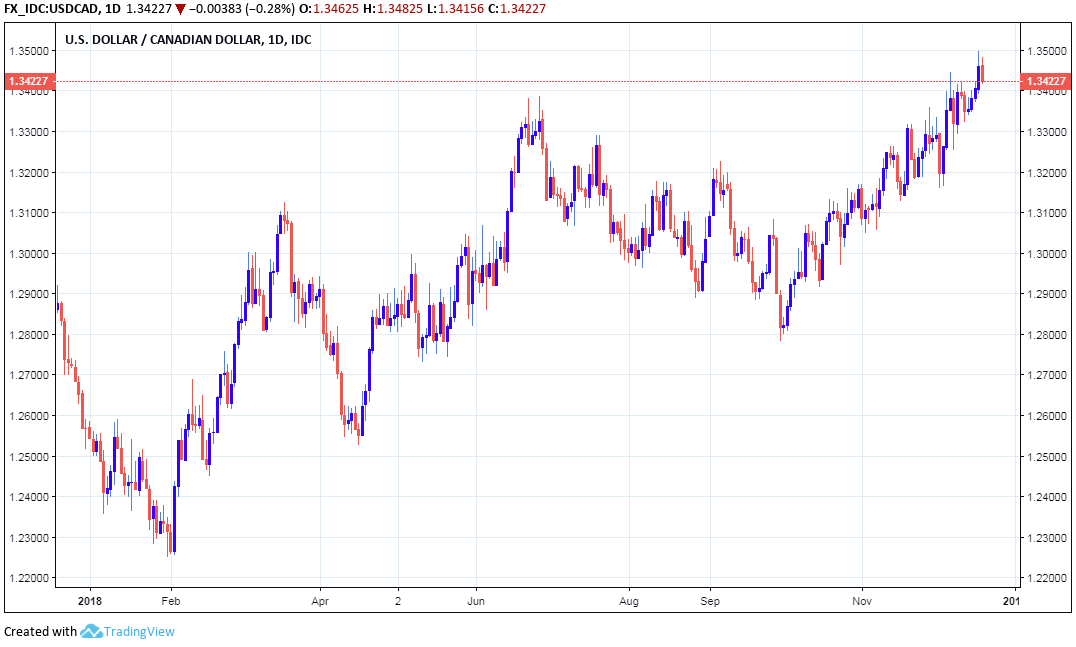Canadian Dollar: Inflation Data Gives Poloz Another Reason to Pause
- Written by: James Skinner
-

Image © Bank of Canada, Reproduced Under CC Licensing
- CAD extends lower after November CPI data shows inflation sliding.
- Oil price collapse drags CPI and core-CPI below BoC's 2% target.
- Providing Poloz more reason to pause, given growth concerns.
The Canadian Dollar extended losses Wednesday after official data revealed a steep fall in inflation during November, which has given the Bank of Canada (BoC) yet another reason to be patient before raising interest rates again.
Canadian inflation fell by -0.4% during November, reversing a 0.3% increase for October and dragging the annualised rate down from 2.4% to just 1.7%, beneath the BoC target of 2%.
The average of Canada's three measures of core inflation, which remove volatile items from the goods basket because of the distorting impact they have on underlying trends, fell from 2% to 1.9% during the month too.
"A 5.4% drop in gasoline prices over the past year accounted for the big come-down from 2.4% inflation in the prior month," says Avery Shenfeld, chief economist at Toronot-headquartered CIBC Capital Markets. "Core prices are still only a hair below the midpoint of the Bank of Canada's target, so where interest rates go from here will be more guided by growth ahead."
The Brent crude oil price, which is the global benchmark, fell by more than 20% to just $58 per barrel during November while the price of Western Canadian Select fell to a new record low.
This not only dented expectations for GDP growth, given oil is Canada's largest export, but has also led analysts to begin projecting a marked fall in inflation over coming months. But not all are on the same page.
"Our commodities team expect prices to trend back above $70/bbl as we move into 2019. The recent Alberta curb on oil production has also seen Western Canada Select (WCS) surge, narrowing the discount it faced relative to benchmark prices. Taken together, these factors should limit some of the downward pressure on inflation in the months ahead," says James Smith, a developed markets economist at ING Group.
Markets care about the inflation data because it has significant influence over Bank of Canada interest rate decisions, which are the raison d'être for most moves in exchange rates.
Changes in rates are normally only made in response to movements in inflation but impact currencies through the push and pull influence they have on capital flows as well as their allure for traders.
"Tame inflation remains consistent with our view that the output gap is probably larger than previously thought based on the recent GDP historical revisions. This situation, combined with the recent deterioration in financial markets argue for an extended pause in the BOC’s tightening campaign," says Matthieu Arseneau, an economist at National Bank of Canada.

Above: USD/CAD rate shown at daily intervals.
USD/CAD was quoted 0.03% higher at 1.3458 following the release after reversing an earlier -0.08% loss, and is now up 7% fo 2018.
Price action comes ahead of the December Federal Reserve (Fed) interest rate statement and economic forecasts, and speculation about what the Fed might say has seen the U.S. Dollar offered lower throughout the week.
Yet the greenback has continued to climb against the Loonie, demonstrating the extent that Canada's currency has fallen from favour with the market.
The Pound-to-Canadian-Dollar rate was -0.17% lower at 1.6999 after paring back an earlier -0.29% loss and is up by just 0.29% for the year.

Above: Pound-to-Canadian-Dollar rate shown at daily intervals.
"The loonie has to contend with plummeting risk sentiment, soggy oil prices and Trump's neverend blasting of the Fed on Twitter. These forces offer conflicting signals for risk currencies like the loonie," says Mark McCormick, head of North American FX strategy at TD Securities. "While the market has already chopped a fair amount of wood on the 2019 Fed trade, we could still see a signal effect if the dots and Powell lean dovish. That's positive for CAD."
The Bank of Canada raised its interest rate by 25 basis points to 1.75% in October and said it will go on lifting its benchmark rate over coming quarters, potentially taking the cash rate up to 3.5%.
But it backed away from that guidance in December following a series of disappointing economic figures and a rout in oil prices.
Investors had until then anticipated that January's BoC meeting would yield what would then be a fourth rate hike inside of 12 months.
Pricing in interest rate derivative markets had implied close a 100% probability of that happening as recently as October, but those markets now suggest there is almost zero chance of such a thing happening.
"We don’t see anything that would change the story in the first couple of quarters of the year. Although the BoC has backed off on its hawkishness, we are still looking for a couple of rate hikes," says Greg Anderson, head of currency strategy at Toronto-headquartered BMO Capital Markets. "So our outlook is for relative CAD strength in H1 of the year."
Advertisement
Bank-beating exchange rates. Get up to 5% more foreign exchange by using a specialist provider to get closer to the real market rate and avoid the gaping spreads charged by your bank when providing currency. Learn more here









